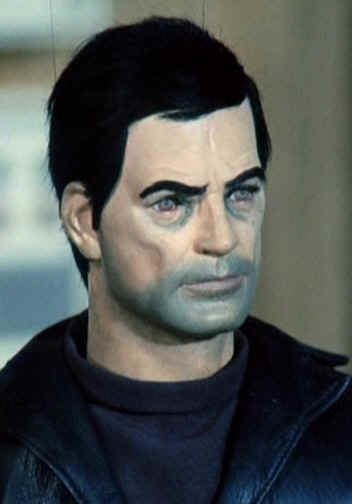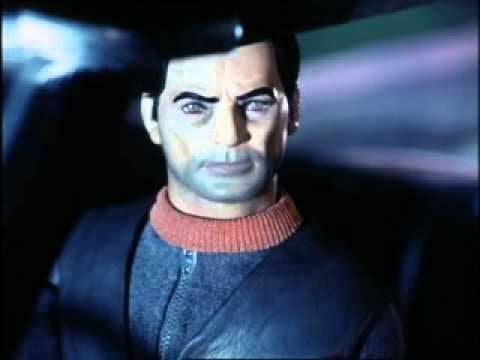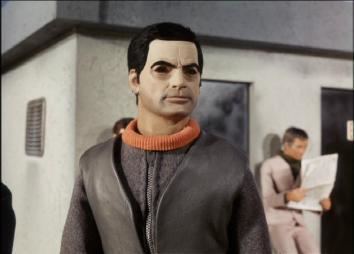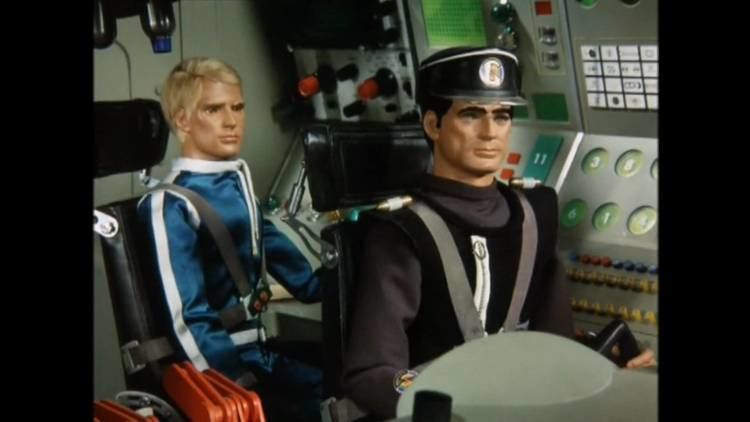Gender Male | ||
 | ||
Voiced by Jeremy Wilkin and Donald Gray(Captain Scarlet and the Mysterons)Gary Martin(Captain Scarlet and the Return of the Mysterons)Nigel Plaskitt(Gerry Anderson's New Captain Scarlet) Aliases Conrad Turner(Captain Scarlet and the Mysterons)Conrad Lefkon(Gerry Anderson's New Captain Scarlet) Species Human (controlled by the Mysterons) Occupation Spectrum officer (formerly) Movies and TV shows Gerry Anderson's New Captain Scarlet, Revenge of the Mysterons from Mars Similar | ||
Captain Black is the fictional nemesis of Captain Scarlet and the primary recurring Mysteron intermediary in the 1960s British Supermarionation science-fiction television series Captain Scarlet and the Mysterons and its 2005 computer-animated remake, Gerry Anderson's New Captain Scarlet. "Captain Black" is a codename; his birth name is not revealed in the original series, although tie-in media have given it as Conrad Turner (original series), in the remake series Blacks's tombstone clearly reveals his name as Conrad Lefkon (S01E01, 13m28). His transformation from human to Mysteron agent occurs on Mars in the first episodes of both the original and new series, "The Mysterons" and "Instrument of Destruction, Part 1".
Contents
Conception

While discussing his approach to writing in a 1986 interview, Captain Scarlet script editor Tony Barwick drew parallels between the premise and characters of Captain Scarlet and those of Thunderbirds – suggesting, for example, that the Spectrum Organisation invited comparisons to International Rescue, and that the character of Black was similar to the main recurring villain of Thunderbirds, the Hood.
Captain Scarlet and the Mysterons

In 2068, Black is seconded to command the Zero-X spacecraft for a manned mission to Mars, assigned with investigating anomalous radio signals detected by the Spectrum Organisation. Previously, Earth was aware only of the existence of rock snakes on the planet (as seen in the 1966 film Thunderbirds Are Go); consequently, Black is alarmed to discover a fully developed, extraterrestrial city on the Martian plains. When the inhabitants – a collective, intangible, artificial intelligence calling itself "the Mysterons" – rotate scanning apparatus towards the Martian Exploration Vehicle (MEV), Black misinterprets the attempt at peaceful first contact as preparations for an attack; believing the Mysterons to be hostile, he orders his subordinates to fire on and destroy the settlement. The Mysterons subsequently use their power of "reversing matter" to reconstruct the city, declare a retributive war against Earth – the first act of which will be the assassination of the World President – and assert mental, telepathic control over Black. After Zero-X returns to Earth, Black disappears, having been transformed into the principal instrument of the Mysterons' campaign of vengeance against Earth for what they judge to have been unwarranted aggression.

Through Black, the Mysterons relay instructions to their reconstructed intermediaries, while compelling him to undertake acts of murder and terrorism through their deep, disembodied voice (in which Black now also speaks). However, even while in the Mysteron's power, Black is not completely devoid of humanity. For example, after becoming a radioactive hotspot in the episode "Manhunt", he captures Symphony Angel while evading Spectrum ground forces and deliberately subjects her to radiation inside an atomic centre, but desists before she is killed and allows her to escape. While Spectrum officers give chase to the SPV that they believe contains Black, but is in fact being driven (badly) by Symphony, Black decontaminates himself and makes his escape. Captain Blue's surprised remark of "So he is alive!" when he sees security camera footage of Captain Black implies that until then they thought he was dead. In various episodes, like "The Mysterons" and "Point 783", he demonstrates the ability to filter out his voice while speaking so only other Mysteron agents can hear him. The Mysterons’ threat that ‘one of you will be under our control’ as well as the fact that he spares Symphony's life and merely disappeared some time after returning to Earth from the Martian expedition has given many fans of the show reason to believe that he did not die and therefore is not a Mysteron reconstruction but simply that Captain Black remains a human, albeit one that is in the thrall of the Mysterons.

According to text features in the comic TV Century 21 and related publications, Black was born Conrad Turner in Manchester, England (for some reason he speaks with a North American accent until his corruption at the start of "The Mysterons", he may have adopted this accent to mask his identity) and was orphaned at 7 months as a result of a brief nuclear war. He was raised by distant relatives who provided little emotional support, causing him to be cold and reclusive during his adolescence. At 15, he entered Manchester Technical Academy (a chapter of the Northern University), and graduated with diplomas in Physics, Space Navigation and International Law; he then went into the Northern University and received diplomas in Science and Technology, all this done in three years. He joined the Royal Air Force and served in the British Civil War at the age of 18. After the country was admitted to the World Government, he achieved renown for his work in the World Army and Air Force, and later as a Fireball XL3 pilot in the World Space Patrol. He was Spectrum's first agent, and oversaw the construction of Cloudbase during the 2060s.
In the episode "Treble Cross", an Air Force test pilot unexpectedly survives an assassination attempt by the Mysterons and aids Spectrum in another effort to apprehend Captain Black. However, he is not deceived when the human pilot poses as his own Mysteron duplicate and evades Spectrum for a second time; Captain Blue infers that the Mysterons have equipped him with a "sixth sense" to warn him of danger. If under threat of imminent capture, Black is able to teleport away from danger – an action demonstrated in the episodes "The Heart of New York", "Model Spy" and "Inferno".
The character is seen to wear his Spectrum uniform only in the pilot episode and in the secondary opening sequence for all episodes thereafter (in which he is shown to be standing symbolically in a moonlit graveyard). On all other occasions, he is wearing civilian clothing– typically black trousers, a black zip-up jacket and an orange sweater. This is presumably so the other Spectrum personnel cannot contact him therefore making him more inconspicuous, harder to pinpoint and aid in his elusiveness.
Gerry Anderson's New Captain Scarlet
There are several differences between the original Captain Black and that seen in the remake series. For example, his surname is Lefkon (as shown on his gravestone in the first episode, "Instrument of Destruction, Part 1"). The voice of the new Black is the same as before Mysteronisation, save when the Mysterons assume direct control over his body. Before Mysteronisation, he is portrayed as a sympathetic character, and his destruction of the Mysteron city is given added justification by the fact that equipment on board the MEV explicitly identifies the Mysteron probe as a weapon. By contrast, after his Mysteronisation he is an almost stereotypical villain, taking pleasure in the acts of murder that he commits; in one episode, he leaves Captain Scarlet chained up next to a doomsday device, complete with digital countdown. However, on some occasions (for example, in the episode "Best of Enemies") Scarlet is able to educe Black's original personality, nearly to the point of breaking the Mysterons' conditioning.
In "Dominion", the series finale, Black is knocked unconscious while attempting to destroy a nuclear facility. On recovering, he claims to have been liberated from Mysteron control, and asks Scarlet to return with him to Mars to launch an attack on the Mysteron city. Although the attack is successful, the Mysterons re-assert control over Black. The final image of the series is of Black watching Scarlet's departing spacecraft, then turning about and walking into the distances; two green rings envelop him, and Black vanishes.
According to promotional materials, Conrad Lefkon was born in Brooklyn, New York and was the son of a local crime lord, and joined the army to escape from the "family business". However, in the series he speaks in an English accent.
Reception
With reference to the original Captain Scarlet and the Mysterons, Morgan Jeffery of the entertainment website Digital Spy refers to Captain Black as being one of the series' "most memorable elements", adding the view that the character's Mysteronised appearance and voice "were absolutely terrifying as a child. His presence, plus the high-level of on-screen violence, made Captain Scarlet a heady cocktail for a young, petrified viewer."
In a 1976 essay, Robert B. Moore criticised Captain Scarlet and the Mysterons for its use of colour symbolism in the contrasting code-naming of Captain Black, a malevolent character, and Colonel White, who is depicted as the benevolent commander-in-chief of Spectrum. Moore cited the series as an example of how "The symbolism of white as positive and black as negative is pervasive in our culture." Daniel O'Brien alludes to the colour-inspired stereotyping, commenting that the characterisation of Black as one of the series's primary villains is "to no one's great surprise". During its BBC2 repeat run in the UK in 1993, the series became a subject of renewed discussion regarding black-and-white dualism. Creator Gerry Anderson responded to accusations of political incorrectness and racism by pointing out that the characters of Lieutenant Green, Melody Angel and Harmony Angel are heroic, despite their African and Asian backgrounds. During this time, the Commission for Racial Equality (CRE) denied repeated claims by journalists that it had submitted a complaint to the BBC for alleged discriminatory language.
Cy Grant, the actor who provided the voice of Green, suggested that the series' symbolism could be interpreted in Judaeo-Christian as well as in purely spiritual terms, with Captain Black embodying the Devil against Captain Scarlet's Christ, who is descended from God in the form of Colonel White.
